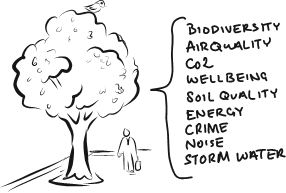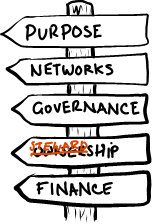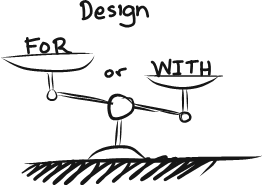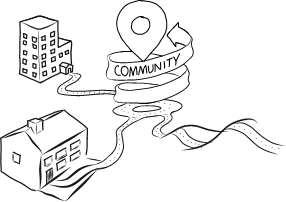Just 26 miles from Glasgow’s Scottish Events Campus, home of COP26, is Dundee’s V&A, the location of the Design Council’s ‘Design for Planet’ conference which took place in November 2021 parallel to COP26. Dundee is the UK’s only UNESCO city of design (one of 40 global cities of design), I was fortunate to attend as 1 of 100 people recognised for work in sustainable design. With a superpower for problem-solving and control of many decisions about how the world around us is made and related to, the discipline of design could make a critical contribution to people’s relationship with the environment.
As a service and system designer working with satellite applications, I have summarised the points from speakers into key themes I think are critical to moving the sustainability agenda forward.
Valuing entanglement

“The reality is that things are entangled, and our current models of thinking and language are all about nouns and objects. If we want to understand the value of a tree, we have to see its value not as timber, but as a multiplicity of benefits, which is contingent on multiplicity of inputs.” Indy Johar
Economics was the recurring meta-topic of the conference. It is central to what is valued and how that value flows through society. For a long time, the basis of the value created by humans (including designers) has been extractive, systematically stripping ecosystems of capital using GDP as a single point of optimisation to understand progress. For example, trees are valued in urban areas until their maintenance and insurance costs outstrip their value as timber. Cutting trees at this point is a failure to account for the accrual of benefits to a range of different beneficiaries (reference Dark Matter Labs work), offering improved health outcomes, productivity, and mitigating extreme weather. What if we understood nature as infrastructure? Similar to how the aggregation of marginal gains helped Britain dominate Olympic cycling, understanding how to measure the distribution and complexity of ‘entangled value’ will help society accumulate win-win relationships in thriving ecosystems. While measuring this value of ecosystem capital might have been a challenge in the past, Indy Johar named advances in satellites and other technology now making this possible (examples from Satellite Application Catapults own projects might include ForestMind, and CommonSensing which also had representation at COP26). Recent reports like the Design Council’s System Design Framework discussed at the conference give designers tools and credibility to collaborate on how entangled value flows can be realised.
Speakers contributing to the theme: Indy Johar (Dark Matter Labs), Kate Raworth (Doughnut Economics Action Lab), Cat Drew (Design Council), Kees Dorst, Simon Jones, Payal Arora, Leyla Acraroglu
Organisational and system design

“I invite everyone to use these five design traits. We need to align the design of our organisations, if we are to unleash the dynamics of regenerative and distributive design in the world.” Kate Raworth
Governments and businesses have been under pressure to commit to environmental improvements and regeneration in the last decade. But few are meeting their commitments. While organisations are reframing their values to meet goals for public interest, the governance, and finance that guide and drive decision-making have not responded to the shift in purpose. Speakers mentioned the challenges of navigating, reorganising, and crafting the intangible matter of public and private institutions as the key to more positive tangible outcomes. Immy Kaur (Civic Square co-founder and at formerly Dark Matter Labs) described it as organisational ‘dark matter’, “the finance, the governance, the types of things that we don’t see, but drives everything.” This organisational matter is increasingly recognised by service designers and system thinkers, working through the different layers that deliver the brand’s promises to users. Considering the fundamentals of value creation shouldn’t be exclusive though. Kate Raworth invited all designers to use their skills to consider how the alignment of five ‘design traits’ affects our organisations and the value they drive: “purpose, networks, governance, ownership/stewardship, and finance.”
Speakers contributing to the theme: Indy Johar (Dark Matter Labs), Kate Raworth (Doughnut Economics Action Lab), Immy Kaur (Civic Square), Leyla Acraroglu.
Just innovation needs participatory design

“We need to stop thinking about this trickle-down economics, innovate in the west, and disseminate to the rest. But rather [there needs to be a mentality of] if they can do it, why can’t we.” Payal Arora
It is impossible to talk about sustainability without discussing climate justice. The conference set the tone with the opening keynote to 17-year-old Anita Okunde to represent the generations most affected by climate decisions. The conference also discussed other dimensions of climate justice, such as supporting low-income economies disproportionately impacted by environmental issues. With past criticism of ‘white saviors’ with well-intentioned (and less well-intentioned) western innovation for people in the global south, there is a question of whether designers should be offering solutions for these communities. Digital Anthropologist, Payal Arora’s message was clear: ‘we are already there.’ Our trade routes exchanging resources are a well-established influence. With China and India alone accounting for 30-40% of the global population, tech companies are already jostling for access to user data in emerging economies. All of these interactions have ethical and environmental consequences, but models of scaling innovations from the west are not always appropriate to conditions in low-income and emerging economies. Auror used the examples of liquid soaps shipped in single-use packaging to users without the recycling infrastructure, causing devastating pollution. The solutions might come from respecting stakeholders with a more participatory approach to design. A great example of this was Cat Drew (Design Council’s, Chief Design Officer) musing with admirable humility that future conferences might be called ‘Design With, and not for, Planet’. It was a conscious re-adjustment we need to make more in design. Wherever our work goes, designers need to bring in multiple dimensions of participatory representation into the design process to guide joined-up decision making, meeting the social and environmental needs in the context of use.
Speakers contributing to the theme: Payal Arora, Finn Harries (Earthrise), Anita Okunde, Cat Drew (Design Council), Orsola de Castro (Fashion Revolution),
The front line of change is how people relate to place

“One of the things I feel we really need to do is embed ourselves into these places, where we are from, we love, we care about, we steward, and actually start to give tangible form to these ideas [for people and planet]. And if we can, the energy is all around us.” Immy Kaur
Gatherings of experts at conferences like COP26 and Design for Planet suggest that an expert will make course corrections in people’s relationship with the planet, giving the feeling of an increasingly disenfranchised public. However, while professions like design can apply their expertise, each profession is only part of the puzzle. We need everyone in society to be part of a transformation. The trouble, as John Thackara noted after 28 years of sharing evidence about societies’ overuse of planetary resources, ‘people won’t behave differently because you tell them to do so.’ Far from perpetuating disconnection environmental theory and design with the public, Design For Planet showcased five or more civic engagement projects re-energising communities’ relationships with their surroundings and empowering people to act in a common interest. Kate Raworth claimed that she founded DEAL (Doughnut Economic Action Lab) to put her economic theories into collaborations where the change happens, with projects like Civic Square. The message from speakers is that we can shape organisations, experiences and give people tools. However, communities need to feel agency and empowerment to harness the potential of design to really transform their relationship with the planet as they make everyday choices.
Speakers contributing to the theme: John Thackara (How to Survive in the Next Economy), Orsola de Castro (Fashion Revolution), Immy Kaur (Civic Square), Carolyn Steel (The Hungry City), Dr Rhiannon Jones (University of Derby), Andy Llanwarne (Climate Beacons), and Rosie Blake (Climate Beacons)
‘Design for Planet’ channeled what I consider to be the real purpose of design. The context was beautiful and engaging, but the event didn’t fetishise aesthetics. It explored ideas that can change our present into a preferred future. There was an acknowledgment of the doors technology opens for us, but the conference retained a tone of actionable hope while shaking off the complacent optimism that technology alone can save us. Speakers showed how design is growing to comprehend the sector’s influence and responsibilities to a safe environment and just society with multidisciplinary system-level interventions. Mention of sustainability and design has still to take hold in reality, but Design For Planet felt like a landmark event, running in parallel to COP26 and discussed with the frankness owed to this existential level challenge. It did lack commitments and outcomes in the same way that COP aspires. However, with the environment now at the heart of the Design Council’s strategy sustainability is here to stay in design, and it must scale quickly to empower the sector. By working with top-down system interventions and empowering ground-up movements, designers might just take ownership of a better future and bring society with it in 2022.
There is a richness and volume to the content from ‘Design For Planet’ that can’t be summed up in four points. Fortunately, all the sessions and more are available online. To view them you need to create an account here: https://www.designforplanet.org/. I recommend diving in if you are interested in sustainability or design.

